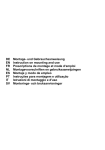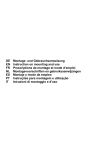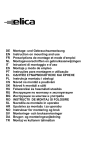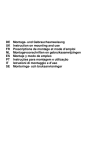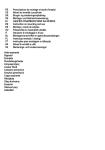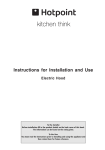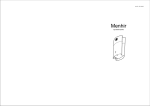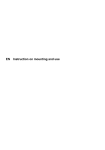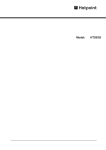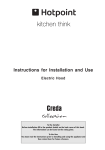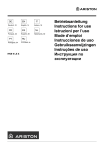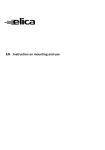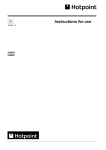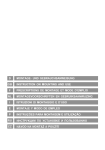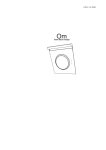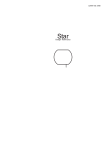Download Elica HORIZONTE EDS3
Transcript
EN Instruction on mounting and use EN - Instruction on mounting and use Consult the designs in the front pages referenced in the text by alphabet letters. Closely follow the instructions set out in this manual. All responsibility, for any eventual inconveniences, damages or fires caused by not complying with the instructions in this manual, is declined. Note: the elements marked with the symbol “(*)” are optional accessories supplied only with some models or elements to purchase, not supplied. Caution WARNING! Do not connect the appliance to the mains until the installation is fully complete. Before any cleaning or maintenance operation, disconnect the hood from the mains by removing the plug or disconnecting the home mains switch. Always wear work gloves for all installation and maintenance operations. The appliance is not intended for use by children or persons with impaired physical, sensorial or mental faculties, or if lacking in experience or know-how, unless they are under supervision or have been trained in the use of the appliance by a person responsible for their safety. Children should be monitored to ensure that they do not play with the appliance. Never use the hood without effectively mounted grating.! The hood must NEVER be used as a support surface unless specifically indicated. The premises must be sufficiently ventilated, when the kitchen hood is used together with other gas combustion devices or other fuels. The suctioned air must not be conveyed into a conduit used for the disposal of the fumes generated by appliances that combust gases or other fuels. The flaming of foods beneath the hood itself is severely prohibited. The use of exposed flames is detrimental to the filters and may cause a fire risk, and must therefore be avoided in all circumstances. Any frying must be done with care in order to make sure that the oil does not overheat and burst into flames. As regards the technical and safety measures to be adopted for fume discharging it is important to closely follow the relations provided by the competent authorities. The hood must be regularly cleaned on both the inside and outside (AT LEAST ONCE A MONTH, it is in any event necessary to proceed in accordance with the maintenance instructions provided in this manual).. Failure to follow the instructions as concerns hood and filter cleaning will lead to the risk of fires. Do not use or leave the hood without the lamp correctly mounted because of the possible risk of electric shocks. We decline any responsibility for any problems, damage or fires caused to the appliance as the result of the nonobservance of the instructions included in this manual. This appliance is marked according to the European directive 2002/96/EC on Waste Electrical and Electronic Equipment (WEEE). By ensuring this product is disposed of correctly, you will help prevent potential negative consequences for the environment and human health, which could otherwise be caused by inappropriate waste handling of this product. on the product, or on the documents The symbol accompanying the product, indicates that this appliance may not be treated as household waste. Instead it should be taken to the appropriate collection point for the recycling of electrical and electronic equipment. Disposal must be carried out in accordance with local environmental regulations for waste disposal. For more detailed information about treatment, recovery and recycling of this product, please contact your local authority. Use The hood is designed to be used either for exhausting or filter version. Ducting version The hood is equipped with a top air outlet B for discharge of fumes to the outside (exhaust pipe and pipe fixing clamps not provided). Attention! If the hood is supplied with carbon filter, then it must be removed. Filter version Should it not be possible to discharge cooking fumes and vapour to the outside, the hood can be used in the filter version, fitting an activated carbon filter and the deflector F on the support (bracket) G, fumes and vapours are recycled through the top grille H by means of an exhaust pipe connected to the top air outlet B and the connection ring mounted on the deflector F (exhaust pipe and pipe fixing clamps not provided). Attention! If the hood is not supplied with carbon filter, then it must be ordered and mounted. The models with no suction motor only operate in ducting mode, and must be connected to an external suction device (not supplied). The connecting instructions are supplied with the peripheral suction unit. Installation The minimum distance between the supporting surface for the cooking vessels on the hob and the lowest part of the range hood must be not less than 50cm from electric cookers and 65cm from gas or mixed cookers. If the instructions for installation for the gas hob specify a greater distance, this must be adhered to. Preliminary information for installation of the hood: Disconnect the hood during electrical connection, by turning the home mains switch off. Remove the fat/s filter/s and the carbon filter frame. Do not tile, grout or silicone this appliance to the wall. Surface mounting only. Do not fix chimney flue to furniture or fly over shelves unless the chimney flue can be easily removed, in case maintenance is ever required. Assembling the chimney flue support/bracket (3 parts): The three parts should be fixed with 4 screws, the support extension is adjustable and should correspond to the internal width of the telescopic chimney flue. Assembling the deflector (only when a deflector composed of 3 parts is supplied – the deflector should be only for the filter version): The three parts should be fixed with 2 screws, the deflector extension is adjustable and should correspond to the width of the chimney flue support, to which it is then fixed. Electrical connection The mains power supply must correspond to the rating indicated on the plate situated inside the hood. If provided with a plug connect the hood to a socket in compliance with current regulations and positioned in an accessible area. If it not fitted with a plug (direct mains connection) or if the plug is not located in an accessible area apply a double pole switch in accordance with standards which assures the complete disconnection of the mains under conditions relating to overcurrent category III, in accordance with installation instructions. Warning! Before re-connecting the hood circuit to the mains supply and checking the efficient function, always check that the mains cable is correctly assembled. Mounting Before beginning installation: • Check that the product purchased is of a suitable size for the chosen installation area. • To facilitate installation, remove the fat filters and the other parts allowed and described here, dismantle and mount it. To remove see also the relative paragraphs. • Remove the active carbon (*) filter/s if supplied (see also relative paragraph). This/these is/are to be mounted only if you want lo use the hood in the filtering version. • Check (for transport reasons) that there is no other supplied material inside the hood (e.g. packets with screws (*), guarantees (*), etc.), eventually removing them and keeping them. • If possible, disconnect and move freestanding or slide-in range from cabinet opening to provide easier access to rear wall/ceiling. Otherwise put a thick, protective covering over countertop, cooktop or range to protect from damage and debris. Select a flat surface for assembling the unit. Cover that surface with a protective covering and place all canopy hood parts and hardware in it. • Disconnect the hood during electrical connection, by turning the home mains switch off. • In addition check whether near the installation area of the hood (in the area accessible also with the hood mounted) an electric socket is available and it is possible to connect a fumes discharge device to the outside (only suction version). • Carry out all the masonry work necessary (e.g. installation of an electric socket and/or a hole for the passage of the discharge tube). Expansion wall plugs are provided to secure the hood to most types of walls/ceilings. However, a qualified technician must verify suitability of the materials in accordance with the type of wall/ceiling. The wall/ceiling must be strong enough to take the weight of the hood. Do not tile, grout or silicone this appliance to the wall. Surface mounting only. Before installing the hood, remove (if present) the wooden protective plate fixed to the rear. Fig. 5 Installation wall model Fig. 6 1. Using a pencil, draw a line on the wall, extending up to the ceiling, to mark the centre. This will facilitate installation. 2. Rest the drilling template against the wall: the vertical centre line printed on the drilling template must correspond to the centre line drawn on the wall, and the bottom edge of the drilling template must correspond to the bottom edge of the hood. 3. Place the lower support bracket on the perforation diagram making it coincide with the traced triangle, mark the two external holes and perforate. Remove the perforation diagram, insert two wall-dowels and fix the support bracket of the hood with two 5x45 mm screws. 4. Hang the hood onto the lower bracket. 5. Adjust the distance of the hood from the wall. 6. Adjust the horizontal position of the hood. 7. Using a pencil mark the cooker hood permanent drill hole inside the suction group (2 fixing points are necessary for permanent mounting). 8. Remove the hood from the lower bracket. 9. Drill at the point marked (Ø8mm). 10. Insert 2 wall screw anchors. 17 11. Apply the flues support bracket G to the wall adherent to the ceiling, use the flues support bracket as a perforation diagram (if present, the small slot on the support must coincide with the line drawn previously on the wall) and mark two holes with a pencil. Make the holes (Ø8mm), and insert 2 dowels. 12. Fix the chimney support bracket to the wall using two 5x45mm screws. 13. Hook the hood onto the bottom bracket. 14. Fix the hood into its final position on the wall (ABSOLUTELY ESSENTIAL). 15. Connect a pipe (pipe and pipe clamps not provided, to be purchased separately) for discharge of fumes to the connection ring located over the suction motor unit. If the hood is to be used in ducting version, the other end of the pipe must be connected to a device expelling the fumes to the outside. If the hood is to be used in filter version, then fix the deflector F to the chimney support bracket G and connect the other extremity of the pipe to the connection ring placed on the deflector F. 16. Connect the electricity. 17. Insert the flue into its housing over the hood to cover the suction unit completely. 18. Fix them above with 2 screws (18a) to the G flues support bracket (18b). Remount the carbon filter frame and the fat/s filter/s and check the perfect functioning of the hood. Additional instructions for the montage Installing the panel (number and form of the panels can vary on the basis of the model) The panel is supplied dismounted. Hook the panel onto the pins of the hood and fix with the supplied latch S (the number varies on the basis of the model - safety-fixing compulsory!). Rotate the panels to cover the suction area and hook to the central pin, pressing with decision. Check that the panel is blocked in position. Fig. 7 Description of the hood Fig. 1 1. Control panel 2. Grease filter 3. Grease filter release handle 4. Halogen lamp 5. Vapour catcher 6. Telescopic chimney 7. Air outlet (used for filter version only) 8. Panel Operation Use the high suction speed in cases of concentrated kitchen vapours. It is recommended that the cooker hood suction is switched on for 5 minutes prior to cooking and to leave in operation during cooking and for another 15 minutes approximately after terminating cooking. Control panel To select the functions of the hood just touch the commands. Light key ON/OFF Intensive speed selection key (suction power) - duration 5 minutes - press again to return to previous setting. High-speed selection key (suction power). Medium-speed selection key (suction power) - when flashing it indicates the need to wash or replace the carbon filter. This signal is normally deactivated. Press keys 1 and 2 at the same time to activate it. At first only key 1 will flash and then both keys 1 and 2 to indicate activation. Repeat the operation to deactivate the signal. At first keys 1 and 2 will flash and then only key 1 to indicate deactivation. Low-speed selection key (suction power) – when flashing it indicates the need to wash the fats filter. Motor key OFF (stand by) – excludes the electronics – reset wash/replace filters signals. MOTOR OFF Press briefly to switch the motor off. RESET FILTERS SIGNALS After having carried out maintenance of the filters, press the key for 3 seconds. Flashing led 1 (fats filter) or 2 (carbon filter) will stop flashing. EXCLUDING THE ELECTRONICS Press the key for 3 seconds. The hood command electronics will be excluded. This function can be useful during the product cleaning operations. Just repeat the operation to reinsert the electronics. If the hood fails to operate correctly, briefly disconnect it from the mains power supply for almost 5 sec. by pulling out the plug. Then plug it in again and try once more before contacting the Technical Assistance Service. Maintenance ATTENTION! Before performing any maintenance operation, isolate the hood from the electrical supply by switching off at the connector and removing the connector fuse. Or if the appliance has been connected through a plug and socket, then the plug must be removed from the socket. Cleaning The cooker hood should be cleaned regularly (at least with the same frequency with which you carry out maintenance of the fat filters) internally and externally. Clean using the cloth dampened with neutral liquid detergent. Do not use abrasive products. DO NOT USE ALCOHOL! WARNING: Failure to carry out the basic cleaning recommendations of the cooker hood and replacement of the filters may cause fire risks. Therefore, we recommend oserving these instructions. The manufacturer declines all responsibility for any damage to the motor or any fire damage linked to inappropriate maintenance or failure to observe the above safety recommendations. Panel Attention! Hold the panel with both hands when dismantling and re-mounting in position to avoid it falling and causing damage to people or things. Dismantling: pull the panel (FRONT SIDE) downward with decision, unscrew safety knob S and unhook it from the rear hinge. Cleaning: Clean the suction panel with the same frequency as the fats filter using a cloth soaked in neutral liquid detergents. Avoid the use of products containing abrasives. DO NOT USE ALCOHOLS. Montage: The panel must be hooked at the back and fixed in front fitted into the pins for the purpose on the surface of the hood. Attention! always check that the panel is well fixed in its place. Grease filter Fig. 2 This must be cleaned once a month (or when the filter saturation indication system – if envisaged on the model in possession – indicates this necessity) using non aggressive detergents, either by hand or in the dishwasher, which must be set to a low temperature and a short cycle. When washed in a dishwasher, the grease filter may discolour slightly, but this does not affect its filtering capacity. Remove the filter holder frame by turning the knobs (g) 90° that affix the chimney to the cooker hood. Charcoal filter (filter version only) Fig. 3 It absorbs unpleasant odours caused by cooking. The charcoal filter can be washed once every two months (or when the filter saturation indication system – if envisaged on the model in possession – indicates this necessity) using hot water and a suitable detergent, or in a dishwasher at 65°C (if the dishwasher is used, select the full cycle function and leave dishes out). Eliminate excess water without damaging the filter, then put it in the oven for 10 minutes at 100° C to dry completely. Replace the mattress every 3 years and when the cloth is damaged. Assembly Place the mat around the grease filter and fix it in place using the devices provided. Position the upper cap and fix it in place using the fixing pin. To disassemble, perform the steps in the reverse order. Replacing lamps Fig. 4 Disconnect the hood from the electricity. Warning! Prior to touching the light bulbs ensure they are cooled down. • Use a small screwdriver as a lever on the borders of the lamp in order to remove the lightbulb. • Slide out the lightbulb to be replaced and replace with a new 12V 20W MAX 30° Ø35 12V GU4. • Carry out the replacement and mount the new lightbulb by following instructions in the reverse. If the lights do not work, make sure that the lamps are fitted properly into their housings before you call for technical assistance. LI3BFC Ed. 03/09










